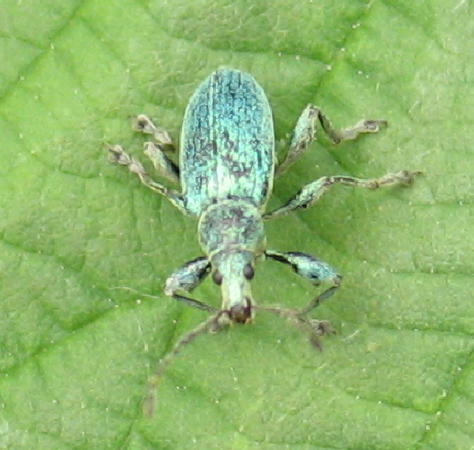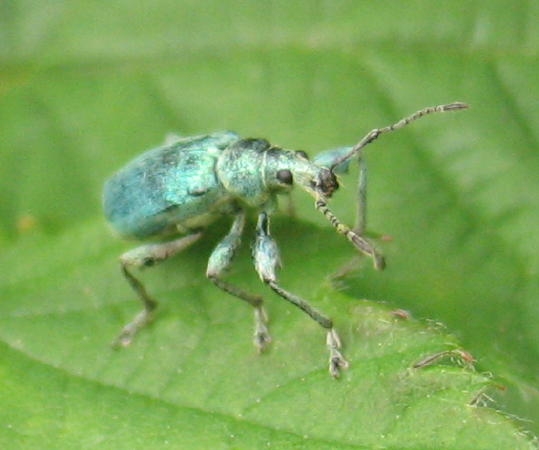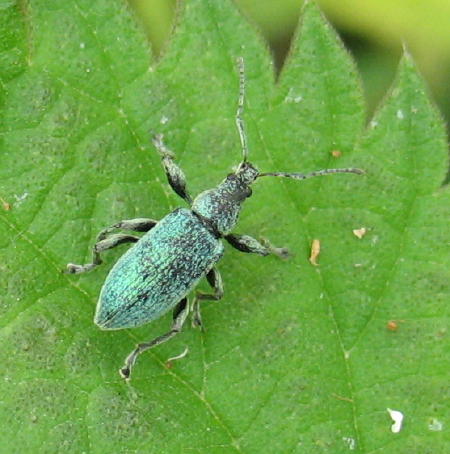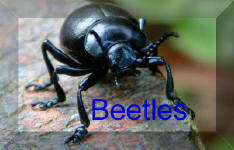Back To

Home > Coleoptera >> Curculionoidea
Phyllobius & Polydrusus
The main Generic differentiator Separating these green weevils is by the position of antennal insertions on the head wheren they emerge from rostrum. In all Phyllobius sp, the insertion point is viewable from above whilst not visible from above in Polydrusus sp.
In progressing the identification further the presence or absence of a tooth on the femora should be noted
TABLE 1
Femora (toothed)
P. argentatus
P. roboretanus
P. glaucus
P. maculicornis
P. viridicollis
P. oblongus .
P. pomaceus .
P. pyri
There is an excellent working Key Here KEY
Species
Toothed front femora Scales Femora colour Tibiae Elytral slope Hairy Phyllobius argentatus
yes round pale fine Phyllobius maculicornus
yes elongate dark fine Phyllobius glaucus
yes pointed pale no Phyllobius pyri
yes elongate dark ridged no Phyllobius oblongus
yes none pale yes Phyllobius pomaceus
yes oval dark no Phyllobius viridicollis
no few dark no Phyllobius roboretanus
no round dark steep no Phyllobius virideaeris
no round dark shallow no Green Nettle Beetle (Weevil) Phyllobius pomaceus
Back To

Home > Coleoptera >> Curculionoidea
Identification Phyllobius is a genus of "short-nosed weevils", in which the rostrum is relatively short and extends little beyond the points of attachment of the antennae.
P. pomaceus is a well-known species but requires attention to critical characters for certain identification. It is by no means the only green weevil of metallic appearanceAlthough described here as "green", it should be noted that the basic colour in this species is black, but with the beetle extensively coated with metallic, typically green to blue-green (sometimes also golden or coppery) scales. With age, more of the black ground colour is revealed as the scales are rubbed off.
There are 10 species of Phyllobius in Britain Morris (2004). A The genus is characterised by a scaly pubescence or by the tiny, metallic scales, which in most species coat the entire dorsal surface of the insect. The colour of these scales varies in many species, including P. pomaceus, from various shades of green to coppery brown. The majority are leaf-eaters, non-specifically on various trees.
The genus Polydrusus is very similar, the distinction being that the "scrobes" (the furrows in the rostrum into which the first joints of the antennae fit) are curved rather than straight – diagram in Joy (1932).
Distribution:Some sources call this the "Nettle Weevil" or the "Green Nettle Weevil", but see below regarding confusion over these names.
What To look For
i) relatively large size, length 7-9 mm;
ii) the femora each bear a conspicuous, more or less ventral tooth (most easily seen on the front pair of legs); and just visible on the Mid Image below
iii) the legs are black beneath the scales;
iv) the antennae are dark beneath the scales, though tinged rust right at the base and sometimes at the tips;
v) nettles (Urtica) as the host plant.

13531


